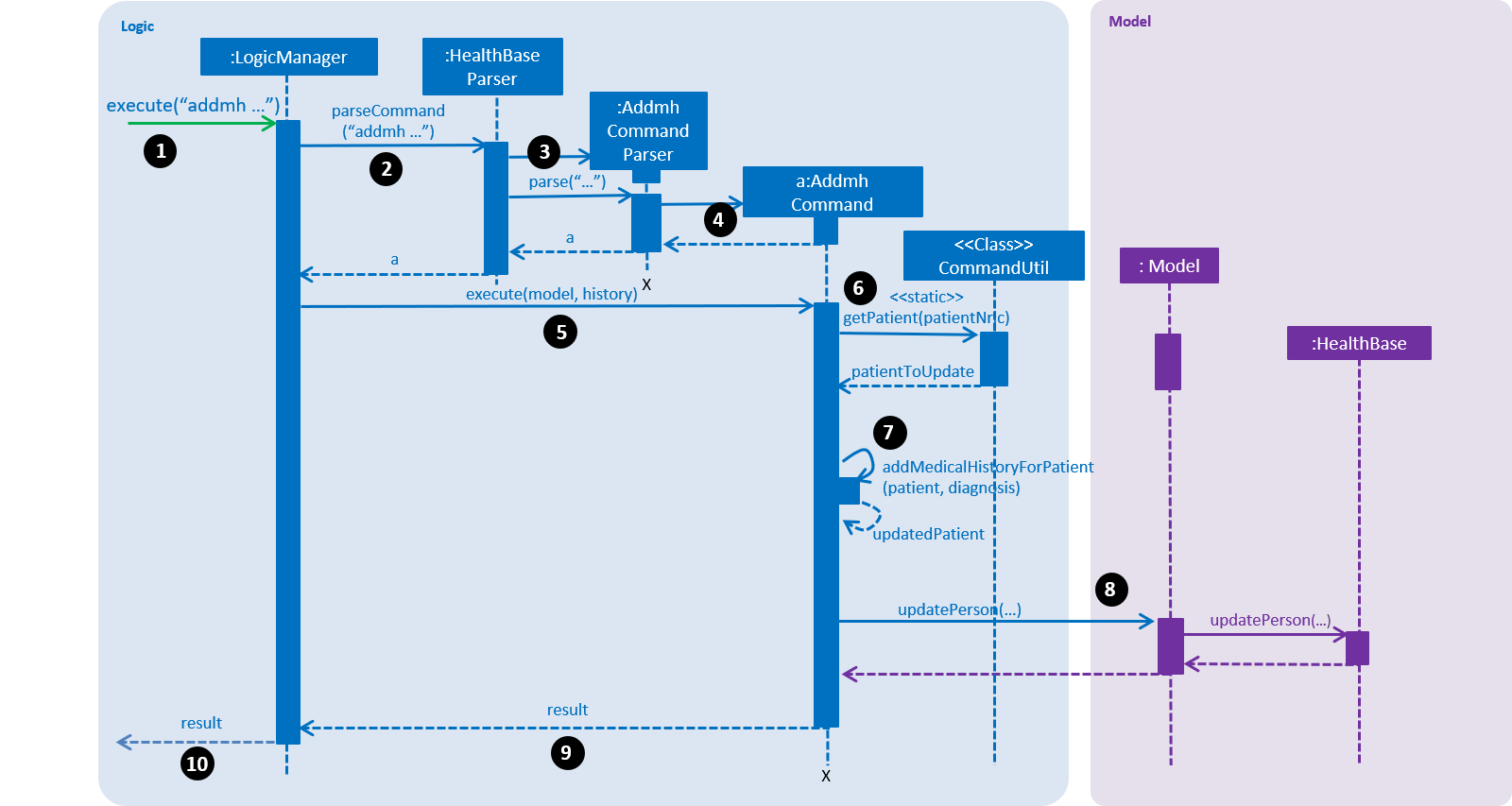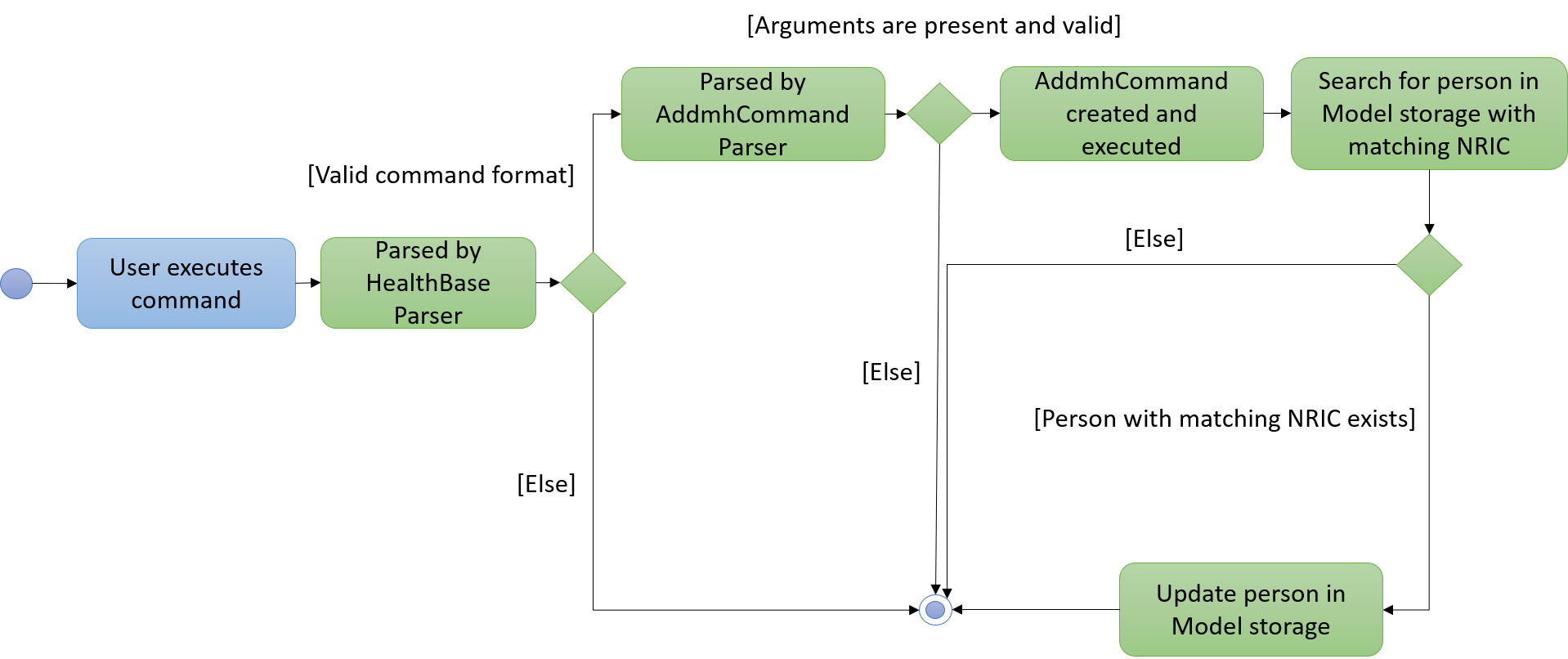PROJECT: HealthBase
1. Overview
Throughout the 8-week period, we were challenged to incorporate the new Software Engineering concepts taught in class via a series of milestones which were part of the project management process. On top of that, we planned out weekly goals and consistently reassessed our employed programming methodologies and practices, developing our software HealthBase incrementally and iteratively. Figure 1 shows the transformations we made in this brownfield project.

HealthBase is a lightweight and free desktop application which automates the tedious data-handling processes of hospital staff. By complementing the roles of receptionists, nurses and doctors and providing convenient features, the app allows its users to efficiently manage patients’ information, thus easing their workload and allowing them to focus on caring for their patients.
The app’s features can be easily accessed by typing short commands into an input field. These features include (among others):
-
Patient medication data entry and retrieval
-
Patient medical history data entry and retrieval
-
Patient dietary restriction(s) data entry and retrieval
-
Patient visitor history data entry and retrieval
-
Patient appointment management for doctors
-
Real-time management of the check-in/out status of patients
-
Real-time management of the number of visitors any given patient has
2. Summary of Contributions
-
Major enhancement: Added the functionality to record and view patients' past medical diagnoses
-
What it does: Records a diagnosis entry into the medical history of a given patient. Each entry includes the diagnosis description, the name of the examining doctor and a timestamp.
-
Justification: This feature serves as the primary storage of important patient data, as adjudged by the examining doctor’s assessment. Past diagnoses are easily viewed on the desktop application to provide quick access for the examining doctor.
-
Highlights: This enhancement required a detailed understanding of the Java Architecture for XML Binding software framework (JAXB) for data storage as XML files. Also, the integration of the UI in the feature needed JavaFX knowledge.
-
-
Code contributed:
-
Other contributions:
-
Project management:
-
Spearheaded project planning and managed project scope as project leader
-
-
Documentation:
-
Refactored existing contents of documentation affected by renaming of "HMS2K18" to "HealthBase": (Pull Request: #132)
-
Wrote the
addmhsection in User Guide and Developer Guide.
-
-
Community:
-
Tools:
-
Integrated Github Plugins (Coveralls, Travis CI)
-
Automated team documentation build on GitHub Pages
-
-
3. Contributions to the User Guide
The sections below detail my contributions to the User Guide. They demonstrate my ability to write documentation targeting end-users. |
Add to patient’s medical history: addmh
Add a non-blank diagnosis entry with the name of the doctor-in-charge to an existing patient’s medical history. The patient must be registered within the system and the doctor’s name should contain his title, which is followed by his full name. For all words in the doctor’s name, the starting letter must be capitalised.
Format: addmh ic/NRIC mh/DIAGNOSIS doc/DOCTOR-IN-CHARGE
Example(s):
-
addmh ic/S1234567A mh/Patient shows symptoms of flu. Prescribed 2 weeks of panadol, advised patient to rest and rehydrate. doc/Dr. Zhang De -
addmh ic/T9876543Z mh/Patient appears to have chronic cough. Referred to specialist. doc/Dr.Timothy
To try out the addmh command:
-
Type out a valid
addmhcommand which follows the stated format into the command box. Such an example can be seen in Figure 2. -
Submit the input into HealthBase by pressing Enter. The result display panel will show a successful
addmhcommand message, and should show the same results in Figure 3.

addmh command.
addmh command.|
If you want to view the newly added diagnoses to a particular patient, simply enter |
4. Contributions to the Developer Guide
The sections below detail my contributions to the Developer Guide. They showcase my ability to write technical documentation and the technical depth of my contributions to the project. |
Addmh
Current implementation
The function of the addmh command is to allow the user to add a diagnosis to a patient’s medical history.
Each patient’s information is stored within a Person object. The execution of the addmh command results in the retrieval of
a particular Person object, and the consequent updating of the patient’s MedicalHistory.
Stated below is an example usage scenario and an explanation of the interactions that occurs as a result of the code execution.
The user executes the following input:
addmh ic/S1234567A mh/Hypertension, diagnosed “years ago”, well contracted with Metoponol doc/Dr. Amos
The purpose of the entered input is to record a diagnosis issued by Dr.Amos, "Hypertension, diagnosed “years ago”, well contracted with Metoponol",
into the medical history of the patient with the NRIC S1234567A.
Command execution
The sequence diagram in Figure 4 below shows the execution of the given scenario:

addmh commandaddmh ic/S1234567A mh/Hypertension, diagnosed “years ago”, well contracted with Metoponol doc/Dr. Amos
-
Firstly, the
Stringuser input is passed into theLogicManager::executemethod of theLogicManagerinstance as the only parameter. -
Then, the
LogicManager::executemethod callsHealthBaseParser::parseCommandwhich receives the user input as a parameter.-
The user input is formatted: the first
Stringtoken is taken as the command word, while the remainingStringis grouped as arguments to be used later by aAddmhCommandParser. -
From the command word, the HealthBaseParser instance identifies the user input as an
addmhcommand and constructs anAddmhCommandParserinstance.
-
-
Next, the
HealthBaseParsercalls theAddmhCommandParser::parsemethod. TheAddmhCommandParsertakes in the remaining string,ic/S1234567A mh/Hypertension, diagnosed “years ago”, well contracted with Metoponol doc/Dr. Amos.-
The string is tokenised to arguments according to their prefixes.
ArgumentMultimap argMultimap = ArgumentTokenizer.tokenize(args, PREFIX_NRIC, PREFIX_MED_HISTORY, PREFIX_DOCTOR); -
A check on the presence of the relevant prefixes
ic/,mh/anddoc/is done. -
If not all prefixes are present, a
ParseExceptionwill be thrown with an error message on the proper usage of theaddmhcommand.if (!arePrefixesPresent(argMultimap, PREFIX_NRIC, PREFIX_MED_HISTORY, PREFIX_DOCTOR) || !argMultimap.getPreamble().isEmpty()) { throw new ParseException((String.format(MESSAGE_INVALID_COMMAND_FORMAT, AddmhCommand.MESSAGE_USAGE))); } -
Otherwise,
DiagnosisandNricobjects are constructed and used as fields in the creation of anAddmhCommandobject.
-
-
Subsequently, the newly created
AddmhCommandis returned to back to theLogicManagerinstance through theAddmhCommandParserandHealthBaseParserobjects. -
Afterwards, when control is returned to the
LogicManagerobject, it calls theAddmhCommand::executemethod.-
The method takes in a
Modelobject to access the application’s data context, the stored data of all persons. -
Its execution sequence may be broken down into the numbered steps in the code snippet below.
public CommandResult execute(Model model, CommandHistory history) throws CommandException { requireNonNull(model); Person patientToUpdate = CommandUtil.getPatient(patientNric, model); (6) Person updatedPatient = addMedicalHistoryForPatient(patientToUpdate, this.newRecord); (7) model.updatePerson(patientToUpdate, updatedPatient); (8) return new CommandResult(String.format(MESSAGE_SUCCESS, patientNric)); (9) } -
-
Next, the stored persons data is accessed in the
CommandUtil::getPatientclass method.-
Model::getFilteredPersonListis called to search for a person with aNricthat matches theNricfield in theAddmhCommand -
If a match is found, the
Personis returned to theAddmhCommand::executemethod.public static Person getPatient(Nric nric, Model model) throws CommandException { ObservableList<Person> matchedCheckedOutPatients = model.getFilteredCheckedOutPersonList() .filtered(p -> nric.equals(p.getNric())); if (matchedCheckedOutPatients.size() > 0) { throw new CommandException(MESSAGE_PATIENT_CHECKED_OUT); } ObservableList<Person> matchedCheckedInPatients = model.getFilteredPersonList() .filtered(p -> nric.equals(p.getNric())); if (matchedCheckedInPatients.size() < 1) { throw new CommandException(MESSAGE_NO_SUCH_PATIENT); } if (matchedCheckedInPatients.size() > 1) { throw new CommandException(MESSAGE_MULTIPLE_PATIENTS); } return matchedCheckedInPatients.get(0); }
-
-
Following that, the
Person's medical history is to be updated.-
The person’s current
medicalHistoryis retrieved, and theDiagnosisfield in theAddmhCommandis added to it. -
Then, a new
Personis created with the updated fields, as part of the immutability of thePersonclass.private static Person addMedicalHistoryForPatient(Person patientToEdit, Diagnosis diagnosis) { requireAllNonNull(patientToEdit, diagnosis); MedicalHistory updatedMedicalHistory = patientToEdit.getMedicalHistory(); updatedMedicalHistory.add(diagnosis); return patientToEdit.withMedicalHistory(updatedMedicalHistory); }
-
-
Then, the old
Person's data will be replaced with the updatedPerson's data.-
Here the
Model::updatePersonmethod is called, and it subsequently calls theHealthBase::updatePersonmethod. -
It replaces the person’s existing data in the storage with the person’s updated data.
// ModelManager.java public void updatePerson(Person target, Person editedPerson) { requireAllNonNull(target, editedPerson); internalHealthBase.updatePerson(target, editedPerson); indicateHealthBaseChanged(); } // HealthBase.java public void updatePerson(Person target, Person editedPerson) { requireNonNull(editedPerson); persons.setPerson(target, editedPerson); }
-
-
The
AddmhCommand::executeexecution completes by returning a newCommandResultthat contains a success message to its calling method,LogicManager::execute. -
Finally the
CommandResultis returned to the caller ofLogicManager::execute, and the execution sequence ends.
The activity diagram below summarises what happens when a user executes the addmh command.

addmh commandDesign Considerations
1. Aspect: How to represent a timestamp in a diagnosis
-
Alternative 1 (current implementation): Use a POJO class to represent the timestamp data in the
Diagnosisclass.-
Pros: Results in improved readability and modularity of code, due to a stronger adherence to the Object-Oriented Programming paradigm.
-
Cons: Increases in modularity can make it difficult to find information, if code becomes over-modularised.
-
-
Alternative 2 (alternative implementation): Use a
Stringto represent the timestamp and contain date-time related functions in theDiagnosisclass.-
Pros: Results in more compact code.
-
Cons: Decreases code modularity, and this decreases code readability.
-
2. Aspect: How to store medical history
-
Alternative 1 (current implementation): Use an ArrayList to store diagnoses in a person.
-
Pros: Allows expandable storage of diagnoses with its dynamic size. As an ArrayList implements the list interface, its contracted functionality suitably represents a list of diagnoses, which makes its usage in developing intuitive.
-
Cons: Slows down performance if the ArrayList capacity is constantly filled due to resizing costs.
-
-
Alternative 2 (alternative implementation): Use an Array to store diagnoses in a person.
-
Pros: Reduces performance losses that may arise from constant resizing of filled ArrayLists.
-
Cons: Decreases flexibility in developing as the Arrays do not support generics in Java.
-